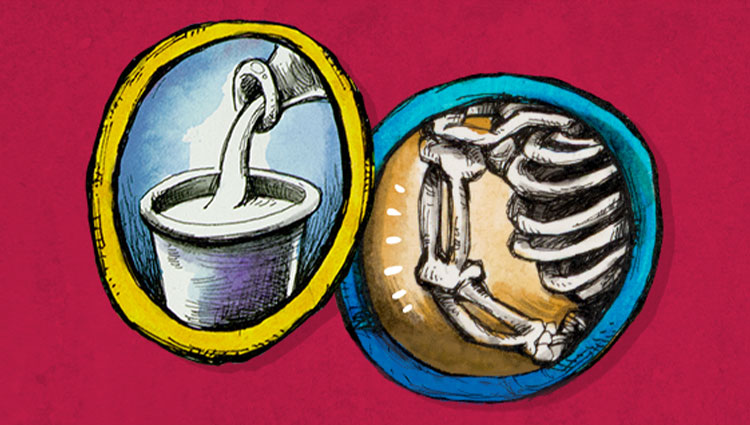When we think of epidemics in the United States, the first thing that often comes to mind is obesity. However, there’s another epidemic to be concerned about: osteoporosis, a globally widespread chronic bone disease and a known “silent killer.” It’s estimated that 64 million Americans over age 50 are affected by osteoporosis and another 47 million have low bone mass, increasing their risk for developing the disease. As health professionals, we each play a role in helping our patients and clients know their risk for this often overlooked ailment.
Although osteoporosis is more common in older adults, it can affect people of all ages. Another risk factor for the disease is gender, with an estimated 1 in 2 women over age 50 and 1 in 4 men over age 50 likely to break a bone from osteoporosis. Additionally, menopause, family history, race, low body weight, poor intake of calcium and vitamin D, poor dietary habits, inactivity, smoking, excessive alcohol intake, certain medicines and other medical conditions can all affect a client’s risk for developing osteoporosis.
Osteoporosis Defined
So what exactly is osteoporosis? Osteoporosis is a health condition that causes the spaces inside the bone to lose strength and density and the outer parts of the bone to become thin and weak. Until roughly age 30, we build more bone than we lose. However, around the age of 35, bone starts to break down faster than it is built up, resulting in a gradual loss of bone mass. Although bone loss is considered a normal part of aging, osteoporosis causes loss of bone mass at a much greater rate than normal and increases the risk for fractures and decreased quality of life.
The Need for Screening and Diagnosis
Osteoporosis is considered a “silent disease” because it often does not display symptoms until a bone fracture occurs. However, in later stages of the disease, symptoms may include back pain, loss of height over time, a hunched posture and frequent broken bones. These fractures can occur from normal stresses – such as bending, lifting or even sneezing – which healthy bones would easily tolerate.
Early detection can have a significant effect on health outcomes. It’s recommended that women age 65 years and older and men age 70 years and older have a bone density test to screen for osteoporosis. Earlier screening may be warranted for clients with additional risk factors.
Options for Treatment and Management
There are a variety of treatment options for a patient or client diagnosed with osteoporosis or low bone mass.
- Medications: There are several medication options available for the treatment of osteoporosis, including hormone therapy, bisphosphonates, biologics and anabolic agents.
- Nutrient supplements: Supplements are also used in the treatment of osteoporosis, especially calcium and vitamin D – often considered the two most important nutrients for maintaining strong bones throughout life. The body also uses calcium as an electrolyte for everyday muscle function, so an inadequate intake of calcium causes the body to “steal” this nutrient from the bones, leading to frail bones. Clients should aim for 1000-1200 milligrams of calcium daily. Dairy foods – like milk, cheese and yogurt – are great sources of calcium. In fact, 1 cup of milk contains about 300 milligrams of calcium. Calcium can also be found in green vegetables such as broccoli, brussels sprouts and kale, as well as in canned fish such as sardines and salmon, and other fortified foods. Vitamin D helps the body absorb calcium. Clients should aim for 400-800 IU daily of vitamin D if under age 50 and 800-1000 IU daily if over age 50. The best way to get vitamin D is from sunlight or supplements, but vitamin D is also found in fatty fish and fortified foods, like milk, orange juice and cereal.
- Balanced diet: Research has shown that diets including a variety of fruits, vegetables, whole grains, dairy foods, nuts and legumes are associated with greater bone mineral density and lower risk for fracture compared to a diet of processed meats, soft drinks, fried foods, desserts and refined grains. Overall, a balanced diet with adequate protein and reduced sodium – and limited caffeine and alcohol – can help protect your bones.
- Exercise: Physical activity is not only important for building strong muscles, but also in maintaining bone mass. It can improve balance, decrease the risk of bone fractures, maintain or improve posture, and relieve or decrease pain. There are two types of exercises that are significant in maintaining bone density: weight-bearing exercises (such as walking, elliptical training and dancing) and strengthening exercises (such as weightlifting, using elastic bands and body weight exercises).
It’s never too early to start thinking about preventing osteoporosis and working to minimize its risks or slow its progression can truly make a difference as we age. This can include helping your patients/clients get enough calcium and vitamin D through foods that support bone health; inspiring them to participate in weight-bearing exercise regularly; and discussing avoidance of smoking and healthy limits on alcohol.
Interested in the science on dairy and bone health? Check out this science summary or get more patient education resources.
Sources:
-
Saad FA. Novel insights into the complex architecture of osteoporosis molecular genetics. Annals of the New York Academy of Sciences. 2020;1462(1):37-52. doi:10.1111/nyas.14231




